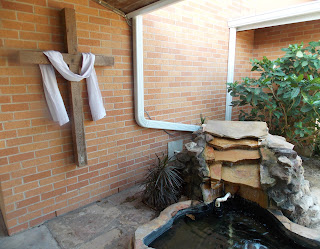The Natchez City Cemetery is quite beautiful in springtime. Large live oaks line the lanes of the garden-like park.
Blooming rows of azalea bushes mark a stark contrast to the white
gravestones.
We chose to make the Natchez
City Cemetery
one of our stops while in the area because of the “Turning Angel”, she is
pictured below.
She does not physically turn under the power of some
mechanical device, which was what I had imagined. Rather, when I walked under
the gaze of her eyes, they seemed to follow me.
The angel is placed in a section of the cemetery where victims of the
1908 Natchez gas explosion are
buried, and I believe that some of those who died were children. The cemetery, established in 1822, has buried in it the
remains of people from as far back as the late 1700s. Those people were moved from churches and
private plantation burial grounds. While strolling
around the cemetery we noticed a section
for the Civil War soldiers, dotted with small Confederate flags. There were also Jewish and German
sections. And we looked for evidence of 19th century iron and marble work, which is a notable feature of the
burial ground.
Saturday evening we attended The Historic Natchez
Tableau. I believe this is the first
time that John and I have ever seen this form of entertainment. It is a representation of a certain theme (in
this case the history of Natchez)
by people or groups of people in costume who pose silently. The tableau depicted the presence of Indians
in the Natchez area, followed by
the coming of the French and then the British.
Sounds a bit boring, right?
However, the period costumes and musical offerings certainly made for a
very entertaining evening. There was a
demonstration of the Virginia Reel and a Maypole Dance. Riverboat entertainers included performances
by actresses representing singer Jenny Lind and ballet dancer Fanny Elser. The showboat era also had its share of bawdy
dancers, as seen in the picture below.
The tableau ended with a soiree depicting southern belles sending their
Confederate boyfriends off to war. We are now driving back to St.Louis where we will be parked for about a month.























 k
k


